The popularity of UX Design combined with the companies' lack of knowledge on the subject has given rise to a phenomenon called UX Theatre.
Have you ever been in a company where you couldn't carry out UX Design processes? Or witnessed executives saying that research is unnecessary because it's a waste of time and they already had customer information?
If so, you have probably experienced the UX Theatre!
This article will discuss why this phenomenon happens and what you can do to avoid it!
What is UX Theatre?
At a first glance, UX Theatre may sound like some UX Design methodology to help understand users’ needs and journeys.
But, unfortunately, it's not about that!
UX Theatre is a term created to describe situations where designers and companies claim to use people-centric approaches, but in reality, don't involve them in any part of the process.
These are situations in which saying that they care about the user experience is just lip service. It's the famous "just for show".
Generally, UX Theatre is promoted by companies that don't allow designers to access user data or involve them in research and Product Discovery processes.
At the end of the day, UX Theatre is this big theater where companies pretend to be user-centered and designers end up joining the dance, pretending to do UX Design work.
Reading Tip: Product Discovery: Identifying Problems And Defining Solutions
Why and how does the UX Theatre happen?
The market for UX and Product Design is growing, that's a fact. The Nielsen Norman Group had already done a survey that predicted an increase of professionals in the market.

In addition, the 2020 pandemic accelerated several digital products, so many companies understood that UX is important to remain competitive and improve their products and brands.
In this sense, it's only natural that companies want to jump into this UX boom, but first, leaders and executives need to know how to start and learn about what UX is — and what is not.
The big problem is that UX Theatre only brings disadvantages to companies. When companies fail to involve users in the process, it becomes really hard to develop a product that meets their needs and provides them with a good experience.
Suppose a product is not tested appropriately and doesn't reflect customer needs. In that case, organizations will see their indicators falling and either won't understand why or will end up blaming UX Design — which makes the situation even more ironic.
"UX Design is vague and anyone can do it"

Besides companies trying to ride the UX Design wave, without really knowing what this area requires, means or needs, there are two other factors that contribute to the manifestation of UX Theatre and that are worth knowing and reflecting upon.
1) UX Design is still something very vague
Because the term UX Design is new—even though thinking about customer experience is already old—companies still don't understand exactly what UX Design means.
It's not like thinking of a Legal or HR area inside a company, where most people will more or less guess what each one of them does.
When the executive level of a company defines that it is necessary to create and invest in UX Design, they often don't know what UX Design is.
This way, creating a UX department ends up being neglected and carried out in such a way that won't benefit the company, quite the contrary, it will only add costs to it.
For example, you have probably heard of cases where companies want to implement a UX division, but the idea is to hire only one designer.
Unfortunately, a one-person army is not practicable, as designers need help to deliver valuable UX Design processes. This is a classic case of UX Theatre.
Therefore, the lack of knowledge about the area and this "vagueness" around what UX is, contribute to companies neglecting their processes and ending up adopting "user experience" merely as a pretty label for people outside the organization.
In addition to this, there is also the issue of UX Designers themselves defining their roles and responsibilities. Is it important to know how to code? Where does UX end and UI begin?
The more we understand the role of UX and what UX Designers do, the more we will be able to communicate these activities and concepts to companies and this may cause the incidence of UX Theatre cases to decrease.
Reading Tip: What’s The Difference Between UX And UI Design? – Understanding Once And For All
2) Anyone can do UX Design
Another thought contributing to UX Theatre cases is the false assumption that anyone can be a designer.
There is a general misconception that design is inherent to the human being and that, therefore, anyone is a designer by birth and, consequently, it's not necessary to study UX.
This statement couldn't be more wrong. Although there is some aesthetic sense and empathy in most people, this does not make them UX Designers just for this reason.
It's the same premise to say that because everyone can, theoretically, paint, anyone could be an artist.
Maybe this belief is linked to the assumption that design is an artistic field and that working with it doesn't require specific skills and expertise.
However, those who think this hardly know that UX Design has much more to do with science than with art itself.
In the end, people who believe that it's not necessary to study UX to work in this field end up neglecting the development of a competent team.
Having a vision that UX Design is just a framework and that anyone can do it, without specific knowledge in the area, diminishes the perception that UX Designers are skilled people with deep knowledge of the subject.
Examples of UX Theatre situations
We have already discussed some situations where UX Theatre occurs, but showing a few more examples is essential to help identify and fight this phenomenon.
In this sense, some of the most common situations where UX Theatre happens are:
- Promoting workshops where team members pretend to be people who are users of the product without actually performing research and testing afterward;
- Creating personas without doing the necessary research, having only the team's opinion;
- Not talking to, interviewing, or conducting research with users at any stage of the product development process;
- Not taking into account eventual feedback from users;
- Base UX Design decisions on opinions and guesswork;
- Investing more time in communicating how the team and the company care about the user experience instead of actually doing research and understanding the customers;
- Assuming that the team understands users and therefore not conducting research;
- Not having a scientific approach, to test and validate assumptions.
Of course, these are just a few examples. The UX Theatre can generate different situations, but with similar signs and origins.
In this sense, The Fountain Institute website summarized the main differences between UX Theatre and real UX Design.

How to avoid UX Theatre?
Fortunately, there are ways to avoid the discomfort and extra costs to the company that UX Theatre can bring.
First, it's essential to recognize the importance of UX design and the costs of not carrying out processes appropriately.
Based on this, it is fundamental to understand how we migrate from fantasy and make-believe situations to real UX Design processes. To do this, we can keep in mind 3 major actions:
1) Spread the word about UX Design
Spreading the word about UX Design means showing the importance of UX processes and of a real user-centered approach.
To do this, you'll need to be patient and resilient. Talking to people about UX will be easier as a company's maturity level rises. Likewise, it will be more challenging in a company with low maturity.
The main point is to disseminate the knowledge and results of UX Design to your peers, people from other teams, stakeholders, and executives.
2) Show the connection between research and UX Design
For those who don't know about the field, UX Design may seem about designing pretty screens and apps.
Most people unfamiliar with UX don't know that UX Design has a lot more to do with research processes and usability than aesthetics.
Therefore, to avoid UX Theatre situations where decisions are based on personal opinions and guesses, it is essential to show the connection between research findings and the solutions.
Reading Tip: UX Research: A Key Role In Product Design
3) Show the work
Sharing the results and reporting everything done—from research, interviews, and tests to the final result and user feedback—are fundamental to avoiding UX Theatre situations.
Also, this will help executives and stakeholders to understand the positive impact UX can bring. This is fundamental to show that UX solutions don't come intuitively or based on opinions.
Therefore, promote sessions to align the work and show the results obtained through it. The best argument is the evidence we show, not just what we say.
These 3 actions to avoid UX Theatre are interconnected and can be done in many ways.
The goal is to share the knowledge and make it explicit so that other people involved in the process – especially in decision-making – understand the importance of research and user involvement for UX to thrive in your company.
UX Theatre is synonymous with bad design

As we have seen, UX Theatre is not necessarily an intentional situation, it's actually connected to the lack of knowledge of UX.
But it's essential for companies to know that UX Theatre ends up being a synonym for bad design.
This is why it's imperative that designers act to break down and eliminate UX Theatre situations in the work environment.
At the end of the day, not involving the user, and not conducting interviews and surveys will result in a bad product experience and, consequently, a bad design.
This situation is complicated for UX professionals also career-wise. It's not interesting to stay in a company whose products are known for bad design and experience.
Therefore, educating people to eliminate UX Theatre is fundamental. And if this awareness process doesn't work and the company keeps neglecting the UX process, it may be a sign that the organization is not ready to think about good design. This might indicate that it is time for you to try other opportunities.
UX Theatre happens, and it's not always easy to combat, especially when you're at the beginning of your career and everything is significantly new. Furthermore, it's essential to be aware that these situations occur and that, as designers, we shouldn't be complicit in this.








